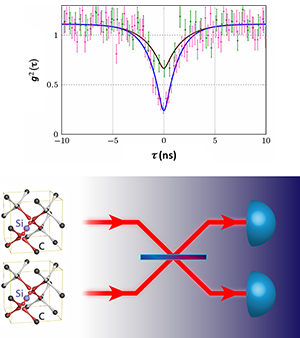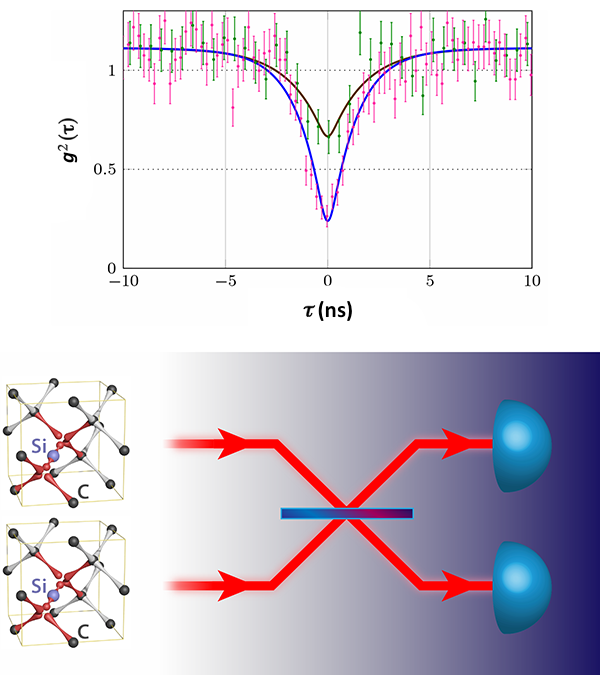Diamond and Silicon Get Entangled
When it comes to semiconductors, it is well known that one shouldn’t bet against silicon. Now it appears that silicon may also be the key to quantum technologies based on diamond. A team of scientists from Harvard University, Ulm University in Germany, and Tsukuba University and the National Institute for Materials Science, both in Japan, has demonstrated that two separated silicon-vacancy (SiV) centers in diamond can emit photons that are indistinguishable [1], i.e., have identical properties (except for their position): same wavelength, same polarization, and when the photons are combined on a beam splitter, the same output directions. Such indistinguishability is one of the most important enablers of quantum information based on atom-photon interactions. It is, for instance, at the heart of measurement-based quantum information protocols, in which computation is carried out by measurements on prepared entangled states: Only if photons emitted from different sources are indistinguishable, can entanglement between them be generated [2]. The finding poses SiV as a potential element for a diamond-based quantum computer.
For many researchers working in the “quantum diamond” space, diamond solely exists as a host for the nitrogen-vacancy (NV) color center. The NV center—in which a nitrogen atom substitutes for a carbon atom and is adjacent to a lattice vacancy—shows properties that make it promising for a variety of quantum applications (see Ref. [3] for a recent review). First, the long-lived, room-temperature coherence between different spin states in the electronic ground states allows sufficient time to process quantum signals. Furthermore, since the NV’s spin sublevels are coupled to optical transitions, they can be manipulated with lasers: By shining green light onto an NV center, the spin will be preferentially pumped into the spin- ground state, whose fluorescence is brighter than that of the spin states [4]. This easy initialization and readout of the spin state, which works at room temperature, is what routinely enables many quantum experiments and applications.
But for all its promise, and despite the many proof-of-concept demonstrations, the NV center has serious deficiencies. The spin polarization that enables the single-spin readout is not [5], and the difference in brightness between spin and spin levels is typically no better than around . These factors increase the number of photons that must be collected to distinguish the different spin states, limiting the speed of operation or requiring complicated schemes to achieve single-shot quantum readout [6]. Even worse, at room temperature, the emission spectrum from an NV center is very broad (over nm), with only of the emission coming from the inhomogeneously broadened “zero phonon line” (the direct excited-state -> ground-state transition that does not involve the excitation of any phonon). This means that the resulting emission frequency cannot be precisely defined, limiting the use of NV’s as sources of indistinguishable photons. While the use of cavities and cryogenic operation can overcome some of these problems, it is hard to escape the conclusion that the NV center is a poor one to start with: paraphrasing Churchill, in diamond, the NV center is the worst color center, except all the others that have been tried.
Yet, as shown by Sipahigil and his co-workers, another option might be at hand. Diamond has over identified color centers, but only a handful of them have shown efficient single-photon emission [7]. Although many of these centers have an emission that is considerably narrower than NV, none of them can be made routinely on-demand, except for NV and the subject of this paper, SiV.
The SiV center has been something of a chameleon for a while: sitting there with its good properties all along, but managing to stay hidden in plain sight. Early studies suggested it might have a high nonradiative recombination rate [8], which is not yet fully understood [9] and would limit the number of useful photons. On the other side, there are more recent reports of very high fluorescence counts from certain SiV centers [10], suggesting it could be an efficient photon source for applications like quantum key distribution. Furthermore, a beautiful mapping of the level structure was measured as a function of magnetic field [11]. The electronic-level structure, if combined with the ability to generate indistinguishable photons, would suggest tremendous potential of SiV for quantum information schemes.
In the present work, Sipahigil et al. study the emission of different SiV centers in diamond. They show that, thanks to the special properties of SiV, two spatially resolved SiV centers can be made to emit photons that are spectrally identical, i.e., they are indistinguishable. Indistinguishability is demonstrated by Hong-Ou-Mandel interference, the simplest nontrivial two-photon quantum interaction. In the Hong-Ou-Mandel effect, when two identical photons simultaneously enter a 50:50 beam splitter from orthogonal directions (see Fig.1, bottom), they demonstrate characteristic “bunching”: because of destructive quantum interference, the two photons must always exit along the same output path (either side of the beam splitter). Bunching is revealed by measuring coincidences between detection events on two photodetectors: If the photons are identical, then both detectors cannot be triggered at the same time, and simultaneous counts on both detectors must go to zero when the delay time between photons is zero. The observed fall in coincidence counts, called the Hong-Ou-Mandel dip, was not complete here, because of a small residual distinguishability between the two emitters (see Fig.1, top), but reached a remarkable value of .
The major factor allowing such two-photon interference is the small inhomogenous broadening exhibited by SiV. This is attributed to the symmetry, which reduces coupling of the center to both strain and other lattice defects (like charged fluctuating defects). They observed a very sharp and efficient zero-phonon-line emission at nm, with a bandwidth as small as MHz [12]. Additionally, unlike the NV center, of the total fluorescence is in the zero-phonon-line transition.
It is worth noting that both previous studes [11] and this new one [1] show a double-Lambda-type structure. A Lambda system consists of two ground states that are not directly coupled by a dipole-allowed transition, but can both be optically coupled to an excited state. In the double-Lambda system, there are instead two excited states, each coupled to both ground states. These Lambda-type structures are the basis of important atom-photon interaction effects, like electromagnetically induced transparency (EIT). One can thus envision that such effects could be immediately ported to SiV in diamond. Such coherent phenomena would open a host of other opportunities for quantum nonlinear optical interactions and sensing opportunities.
Sipahigil et al. did not identify any of the SiV transitions as being suitable for hypothetical use as a qubit, nor did they determine the coherence time for any of the spin levels. But given diamond’s remarkable propensity for long-lived spin coherence, it is likely that suitable SiV long-lived qubit transitions can be identified. The authors also note the possibility of using a SiV based on Si (the Si isotope with spin ), exploiting the nuclear spin of the isotope as a long-lived memory.
Because the SiV center seems to avoid many of the pitfalls of NV, it seems likely that many diamond researchers will realign their activities to explore this new playground. Skeptics of the potential of diamonds for quantum applications may also find themselves drawn to SiV’s attractions. One thing is for certain, however, when it comes to quantum computing, silicon is making diamond shine just that little bit brighter.
This research is published in Physical Review Letters.
References
- A. Sipahigil, K. D. Jahnke, L. J. Rogers, T. Teraji, J. Isoya, A. S. Zibrov, F. Jelezko, and M. D. Lukin, “Indistinguishable Photons from Separated Silicon-Vacancy Centers in Diamond,” Phys. Rev. Lett. 113, 113602 (2014)
- Y. L. Lim, S. D. Barrett, A. Beige, P. Kok, and L. C. Kwek, “Repeat-Until-Success Quantum Computing Using Stationary and Flying Qubits,” Phys. Rev. A 73, 012304 (2006)
- M. W. Doherty, N. B. Manson, P. Delaney, F. Jelezko, J. Wrachtrup, and L. C. L. Hollenberg, “The Nitrogen-Vacancy Colour Centre in Diamond,” Phys. Rep. 528, 1 (2013)
- For simplicity we are only referring here to the electronic spin-1 system
- K.-M. C. Fu, C. Santori, P. E. Barclay, L. J. Rogers, N. B. Manson, and R. G. Beausoleil, “Observation of the Dynamic Jahn-Teller Effect in the Excited States of Nitrogen-Vacancy Centers in Diamond,” Phys. Rev. Lett. 103, 256404 (2009)
- P. Neumann, J. Beck, M. Steiner, F. Rempp, H. Fedder, P. R. Hemmer, J. Wrachtrup, and F. Jelezko, “Single-Shot Readout of a Single Nuclear Spin,” Science 329, 542 (2010)
- I. Aharonovich, S. Castelletto, D. A. Simpson, C.-H. Su, A. D. Greentree, and S. Prawer, “Diamond-Based Single-Photon Emitters,” Rep. Prog. Phys. 74, 076501 (2011)
- C. Wang, C. Kurtsiefer, H. Weinfurter, and B. Burchard, “Single Photon Emission from SiV Centres in Diamond Produced by Ion Implantation,” J. Phys. B 39, 37 (2006)
- T. Feng and B. D. Schwartz, “Characteristics and Origin of the 1.681 Ev Luminescence Center in Chemical-Vapor-Deposited Diamond Films,” J. Appl. Phys. 73, 1415 (1993)
- E. Neu, D. Steinmetz, J. Riedrich-Möller, S. Gsell, M. Fischer, M. Schreck, and C. Becher, “Single Photon Emission from Silicon-Vacancy Centres in Chemical Vapour Deposition Nano-Diamonds on Iridium,” New J. Phys. 13, 025012 (2011)
- C. Hepp et al., “Electronic Structure of the Silicon Vacancy Color Center in Diamond,” Phys. Rev. Lett. 112, 036405 (2014)
- Such value is very close to the smallest achievable bandwidth, as determined by the excited state lifetime at a temperature of 5 K





